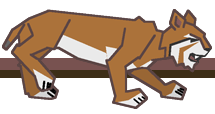in food chains; that organisms and resources in
an environment are closely linked. Overview & Teachers’ Guide.
The panel on the right shows an animation of Kelly Clarkson, a TV news reporter, at the Taiga Wildlife Reserve in Canada. Click on the picture of Kelly to find out why she's come to the reserve, and then click on each of the other characters to find out what they have to say. Your task is to research the conservation issues with Kelly, and to present your views about how to solve the problem of the disappearing snowshoe hares. When you have listened to each of the characters, investigate their views in more depth by clicking the links at the top of the screen – 'A Local Hunter', 'A Teacher' and 'A Conservationist'. Remember, you can click 'ENLARGE' to see a larger version of the animation. Click 'NORMAL VIEW' to return to this page. Additional teacher's notes Individuals or groups of students can be given an 'in role' task of presenting a case to manage animal populations in a habitat. The material on the site contains further information, an interactive case study, structured questions and internet links to support their research. Alternative suggestions are that the students prepare an article (as in the Adaptation assignment), a PowerPoint presentation or a radio or television debate. More detail on suggested timings are given in the Teachers' Guide. The interactive graphic shows Kelly Clarkson, a TV news reporter, in a taiga forest setting. Next to her are three figures (rollover for labels): Beth Johnson, teacher; Jim 'Trapper' Jones, a hunter and Matt Snow, a forest ranger. If you wish, use the Energy Optimisation activity from the Starter section as a stimulus to renew students' familiarity with the lynx-hare relationship. The next part of this session is a research activity and students will be expected to explore the topic in depth using both this site and the external websites suggested. Use this introductory screen to set the scene with the students. The scenario is an investigative journalist's quest to discover why snowshoe hares are disappearing from a widlife reserve and what (if anything) can be done to stop it. The argument of each of the characters involved is given in the Student View and offers a gateway to further research. You will need to consider the final outcome of this activity with care. To have the students role-play a public meeting, for example, would be very dramatic, or you might choose a different format: Kelly's final article for her newspaper, another piece of text highlighting the key ideas, a radio script or a PowerPoint presentation. Whichever outcome you choose, it is important the whole group gathers following their research to take part in feedback and sharing. |
Reporter:
Locals here are mystified by the disappearance of snowshoe hares inside the Taiga Wildlife Reserve. The cute big-foot bunnies are just not seen as often as they used to be! Everyone seems to have a different explanation – and a different solution. Let's hear what each of these folks has to say…Forest ranger: Hi! I'm Matt Snow, forest ranger. There's a delicate balance of nature in the reserve. We just don't know enough about the lives of either the hares or the lynxes to risk doing what Beth and Jim want us to do. It's best if we keep counting the animals and see how things go for the next few years.Teacher: Hi! I'm Beth Johnson, teacher. I often walk the forest paths in the reserve, and sometimes take my pupils there for field trips. We used to see the hares frequently if we were quiet. Now, we're lucky if we see one a term! The kids miss them. Can't the reserve start a breeding programme to release more hares into the forest?Hunter: Hi! I'm Jim Jones, hunter. Since the reserve was set up five years ago and game hunting was stopped, there's just too many lynxes around eating up the hares. Kids ain't safe in the forest now, neither. Can't the reserve lift the ban on shooting lynxes? The hares would soon be back. |
